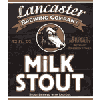Lancaster Brewing Company - Lancaster Milk Stout
-
ABV:
5.30% -
Int’l Bittering Units (IBUs):
22 -
Serving Temperature:
50-55° F -
Suggested Glassware:
Pint Glass or Mug -
Malts:
2-Row Pale, Caramel, Roasted Barley, Chocolate Malt, Black Malt (& Lactose) -
Hops:
Cascade, Goldings
Just shy of black with a tan colored head, expect big, rich, unmistakable stout notes, with hints of dried plum, dark chocolate, coffee, and a prominent lactic edge that suggests hints of acidity. On the palate, look for a flavor progression that starts with clean, dry stout notes (coffee, dark chocolate, dark fruits) and quickly develops a lactic sweetness in the middle. Despite the name, it doesn’t taste like milk, but it has a similar faint sweetness from the lactose (milk sugar), added during brewing in this style of beer because this sugar cannot be metabolized by the yeast during fermentation, remaining in the beer and providing some natural sweetness and adding extra heft to the body. Note a pronounced coffee and dark chocolate-like bitterness and ample roasted malt notes, with a flash of vanilla bean, to close things out. Some minor orange notes and citrusy bitterness arrive as the beer warms, and upon warming further, look for notes of molasses and toffee and mild sourness in the fade. Cheers!
Lancaster County, Pennsylvania, was at one point responsible for producing seven percent of all beer brewed in the United States. The brewing tradition in the region was spurred by innkeepers who brewed beer in back rooms, but by the late 18th century, English and Scottish immigrants had become brewers on much larger scales. In the 1840s, German lagers came to town along with German immigrants who brought with them "new" brewing techniques and expanded the repertoire from English and Scottish ales to German lager beers (which ultimately supplanted the former). During this period, Lancaster's newspaper, The Daily Intelligencer, dubbed the city the “Munich of the United States.”
Even at the height of Prohibition, many brewers in Lancaster refused to stop brewing. Some did it right out in the open until forced to shut down, others set up hidden 'breweries within breweries' in order to keep the beer flowing. But all local beer production stopped in 1956, when the last of Lancaster's Pre-Prohibition breweries shut down. The town wouldn't see another until nearly 40 years later, when The Lancaster Malt Brewing Company opened its doors in April of 1995. For the past 13 years it's been continuously operating as a restaurant and brewery, although ownership, and the brewery name, changed in 2002.
Master Brewer Christian Heim has been with the brewery since it opened in 1995; his great respect for the brewing traditions of old Lancaster, coupled with his modern know-how, are largely responsible for the solid reputation LBC's beers have built.
For more information about the Brewery or their restaurant (the Walnut Street Grille), give them a call at (717) 391-6258.

Unmatched Variety by style, brewery & country
Choose from Five different Beer Clubs offering unmatched variety by brewery,
country of origin, and beer style to suit your specific tastes.


